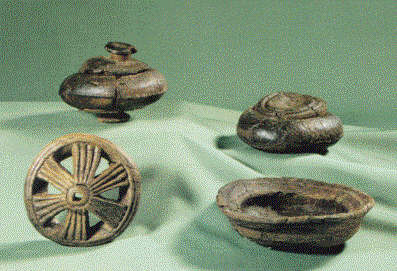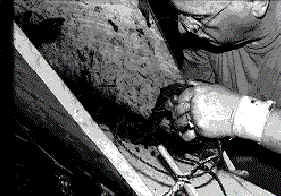The Tools, Utensils ...
The Hjortspring find includes other things apart from the boat and the weapons. A variety of everyday things were found.
A few bronze things were found - two thin strap-tags, a clothing-pin, a button and a peace of bronze sheet. The bronze sheet had traces of soot, which might indicate that its part of a kettle.
A lot of wooden tools and utensils were found.
Some of the most interesting is the oldest turned wood in the Northern Europe.
Picture, courtesy of (1), fig. 20, p. 29.
click the picture to get a larger one (50 kb)Three small canisters with a diameter of nearly 10 cm (4 inches). Two of the canisters have small pedestals and lids with a knob similar to the pedestal. The last canister has no pedestal and a flat lid without a knob.
A small bowl or soup plate with a diameter of 13 cm (5 inches)
A wooden disc with a square hole in the centre surrounded by 6 spokes separated by open-work triangles. The use of this disc has not yet been determined by the archaeologist, we do have a theory, which, for the time being (Mar. 1998), are under investigation.
A small ornamented round box with lid. The sides is made up of a cylinder with a diameter of 10 cm (4 inches) and 5.5 cm (2 inches) high. Inside in top and bottom is a rabbet for the bottom plate and the lid.
Picture, courtesy of (2), fig. 35, p. 64Another interesting find is an S-formed stick of hard wood carefully rounded and smooth. The S-bend in one end is strong and short, in the other end less bent. The stick is 29 cm (11.5 inches) long and the .of the stick is extended to both sides across the S-bend to a 5 cm (2 inches) cross piece. In the middle of this crosspiece is a drilled hole with a diameter of 0.8 cm (0.3 inches). The edges of the hole are rounded and worn towards the end of the stick on the concave side and towards the stick itself on the convex side. Lengthways in the crosspiece is a hole with diameter 0.3 cm (0.1 inch) hole. In the middle of the stick is a hole across the S-bend with diameter 0.5 cm (0.2 inches). And finally in the end opposite to the crosspiece is a drilled hole from the end out through the convex side of the stick.
In our work with the reconstruction of the boat, we have realized that this tool is very useful for tightening the stitches that keeps the planks together.
Picture, courtesy of (3).
Sewing the stemblock.


